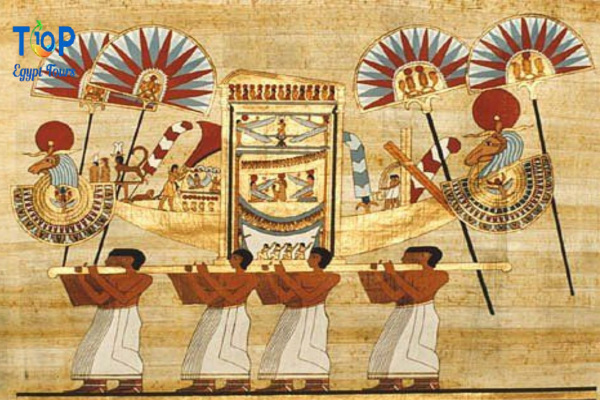Festival of Opet, Welcome to the enchanting world of Ancient Egypt, where history comes alive through vibrant festivals and majestic rituals. In this edition of “Ancient Egyptian Festivals and Rituals,” we delve into the grandeur of the Festival of Opet, a celebration that once echoed through the temples and streets of Egypt, bringing together people from all walks of life.
In this article, we will uncover for you the Festival of Opet with Top Ten Egypt.
The Festival of Opet:
The Festival of Opet, also known as the Feast of Opet, was one of the most significant religious events in ancient Egyptian culture. This annual celebration was dedicated to the rejuvenation of the pharaoh’s power, the renewal of divine cosmic order, and the prosperity of the land.
This annual event, known as the “Beautiful Feast of Opet,” was a spectacle that embodied the spirit of renewal, rejuvenation, and divine connection. Picture this: majestic barques adorned with gold and precious stones carrying the statues of revered deities, Amun-Re, Mut, and Khons, along the Nile River, followed by thousands of jubilant participants.
The Origins of a Magnificent Celebration:
The Festival of Opet dates back to the Middle Kingdom (2055-1650 BC) and reached its peak during the New Kingdom (1570-1069 BC). Held in the city of Thebes (modern-day Luxor), it was deeply rooted in Egyptian beliefs about the divine order and the importance of maintaining Maat, the cosmic balance.
The procession began at Karnak Temple, which was dedicated to Amun and his wife Mut. The statue of Amun was carefully removed from the temple and placed on a specially designed barge, which was then carried by priests along the Nile River to Luxor Temple. Along the way, the barge stopped at various points to allow people to pay their respects and offer prayers to Amun.
At Luxor Temple, the statue of Amun was placed in a special chamber called the “House of Gold,” where it remained for several days. During this time, there were various rituals and ceremonies held in honor of Amun, including offerings of food, drink, and precious objects.
Significance:
Renewal of Pharaoh’s Power: The central theme of the Festival of Opet was the renewal of the pharaoh’s divine power. During the festivities, the pharaoh, considered the living god on earth, would undergo a symbolic re-coronation, reinforcing his connection with the gods and ensuring the continued prosperity of Egypt.
Reconciliation of Amun and Mut: The primary deities honored during the festival were Amun, the king of the gods, and his consort Mut. The rituals performed aimed to reinforce the cosmic balance and the harmonious relationship between these powerful deities.
Fertility and Prosperity: The festival’s connection to the annual flooding of the Nile emphasized themes of fertility and abundance. The Egyptians believed that the flooding brought rich, fertile silt, ensuring bountiful harvests and prosperity for the kingdom.
Activities and Processions:
Sacred Boat Procession: A highlight of the Festival of Opet was the sacred boat procession. The statues of Amun, Mut, and their son Khonsu were placed on magnificently adorned boats and paraded along the Nile. The boats were accompanied by priests, musicians, and jubilant crowds.
Offerings and Rituals: Elaborate ceremonies and rituals were conducted in the temples dedicated to Amun, Mut, and Khonsu. Offerings of food, drink, and precious items were presented to the deities, symbolizing the gratitude of the people and seeking divine favor for the coming year.
Public Celebrations: Beyond the temple rituals, the festival extended into the streets of ancient Egyptian cities. The populace would join in festivities, participating in music, dance, and communal feasts, creating an atmosphere of joy and unity.
The Festival of Opet stands as a testament to the spiritual richness and cultural vibrancy of ancient Egypt. As we explore these grand processions and rituals, we gain a deeper understanding of the profound connection between the Egyptian people and their gods. Join us on this virtual journey back in time, where the Nile’s waters flowed with life, and the Festival of Opet echoed through the magnificent temples of a civilization that continues to captivate our imaginations today.



Comment (0)